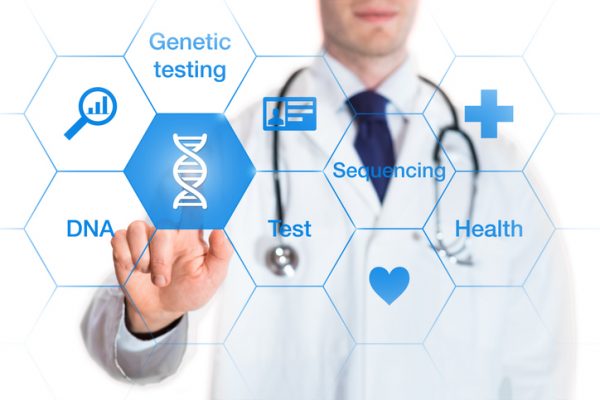
Bloodlines, of course, run deep, which can place a blistering spotlight on those genetically at risk for conditions like cancer.
It’s prompted some medical facilities to incorporate genetics into their primary care setting to help individuals avert what could otherwise amount to a game of Russian Roulette with their lives.

With the Rise of AI, What IP Disputes in Healthcare Are Likely to Emerge?
Munck Wilson Mandala Partner Greg Howison shared his perspective on some of the legal ramifications around AI, IP, connected devices and the data they generate, in response to emailed questions.
To help cut down cancer disparities and deaths, OSF HealthCare, an integrated health care network, recently announced it’s in the early stages of rolling out this EHR integrated solution to primary care practices throughout the system. The software has been developed by CancerIQ, which is based in Chicago and develops genetic cancer risk assessment software.
In 2015, the Peoria, Illinois health system’s innovation team kicked off a collaboration with CancerIQ to improve the assessment, identification and empowerment of those with higher cancer risk than others. Initially, the platform was used in specialty clinics like oncology, breast imaging and women’s health. It’s now being tested at primary care sites with plans to scale it system-wide.
“We wanted the ability to identify women with a genetic predisposition to hereditary cancer across our Ministry,” said Rob Jennetten, director, Innovation Partnerships, OSF HealthCare in response to an email query. “To impact more patients prior to mammography screening age or a cancer diagnosis, the ideal place is primary care.”
He noted the counties surrounding OSF HealthCare, with locations in Illinois and Michigan, have a high incidence of breast cancer. What’s more, almost 20 percent of those patients are diagnosed under 50. Consequently, explained Jennetten, the move by OSF hones in on pinpointing women with a genetic predisposition for hereditary breast cancer, which tends to be earlier onset and aggressive.
Leveraging CancerIQ’s software to date, OSF HealthCare’s screened nearly 70,000 patients; one in four of whom had elevated risk for hereditary cancer, according to national guidelines.
More broadly, due to quickly changing guidelines and industry regulations; not to mention too little time and knowledge, screening women in primary care settings has been a challenge, he noted. But thanks to the technology behind CancerIQ, using individual genetic factors – all within Epic’s workflow – over time, it’s easier for providers to identify, evaluate and manage patients.
The software’s a workhorse. It not only analyzes family history and runs predictive models, but it also automates National Comprehensive Cancer Network Clinical Practice Guidelines in Oncology, he said. On top of that, it abets clinicians in comprehensive clinical decision support and provides patients with tailored education resources and prevention plans.
Furthermore, by tapping CancerIQ’s technology and using individual genetic risk factors, hospitals can identify, evaluate and oversee entire patient populations.
“Cancer be prevented — or caught early”– by community-based providers with genetic expertise by analyzing family history, running predictive risk models and automating NCCN guidelines, explained Jennetten.
Notably, some of the country’s foremost health systems have quickly adopted the platform, which fully integrates with genetic labs, EHRs and specialty software vendors to not only improve patient outcomes but also streamlines workflow, guide clinician decision making and save money, he added.
Last year, Pennsylvania based Geisinger Health System announced that it would offer DNA sequencing to 1,000 patients – while ultimately aiming at extending the service to all three million Geisinger patients.
However, some believe that the use of genetics in primary care has been limited by barriers to integration. According to a study published in Nature, primary care provides most often noted barriers such as a lack of knowledge about genetics and genetic risk assessment, concern for patient anxiety, lack of access to genetics and time, preventing them from applying genetics to routine care.
“We’re working to build the necessary education for our Advanced Practice Providers to be geneticists,” said Naresh Agarwal, MD, regional director primary care, OSF HealthCare. “By putting genomics decision support into the EMR, we can help circumvent the challenge of clinicians implementing this into their daily workflow and support them to do more than just precision medicine. They can now do precision prevention screening.”
Meanwhile, the American Medical Association, https://www.ama-assn.org/delivering-care/population-care/new-brca-recommendations-what-primary-care-doctors-must-know, reported that the U.S. Preventive Services Task Force has updated its recommendations on screening for the BRCA1 and BRCA2 genetic mutations that account for 15 percent of ovarian cancer cases and between 5 percent and 10 percent of breast cancer cases.
The USPSTF’s recommendation statement, published in JAMA along with the task force’s evidence report reflects a major shift from the organization’s 2013 recommendations, broadening the pool of women for whom primary care physicians should perform a risk assessment and, possibly, refer for genetic counseling and testing.
Unlike in the past, when USPSTF recommendations called for risk assessment for women with a family history of breast cancer, ovarian cancer — or both, today, that’s been expanded to encompass women who’d had ovarian or breast cancer but are now cancer-free. Women with ancestry associated with BRCA1 or BRCA2 genetic mutations also are included.














